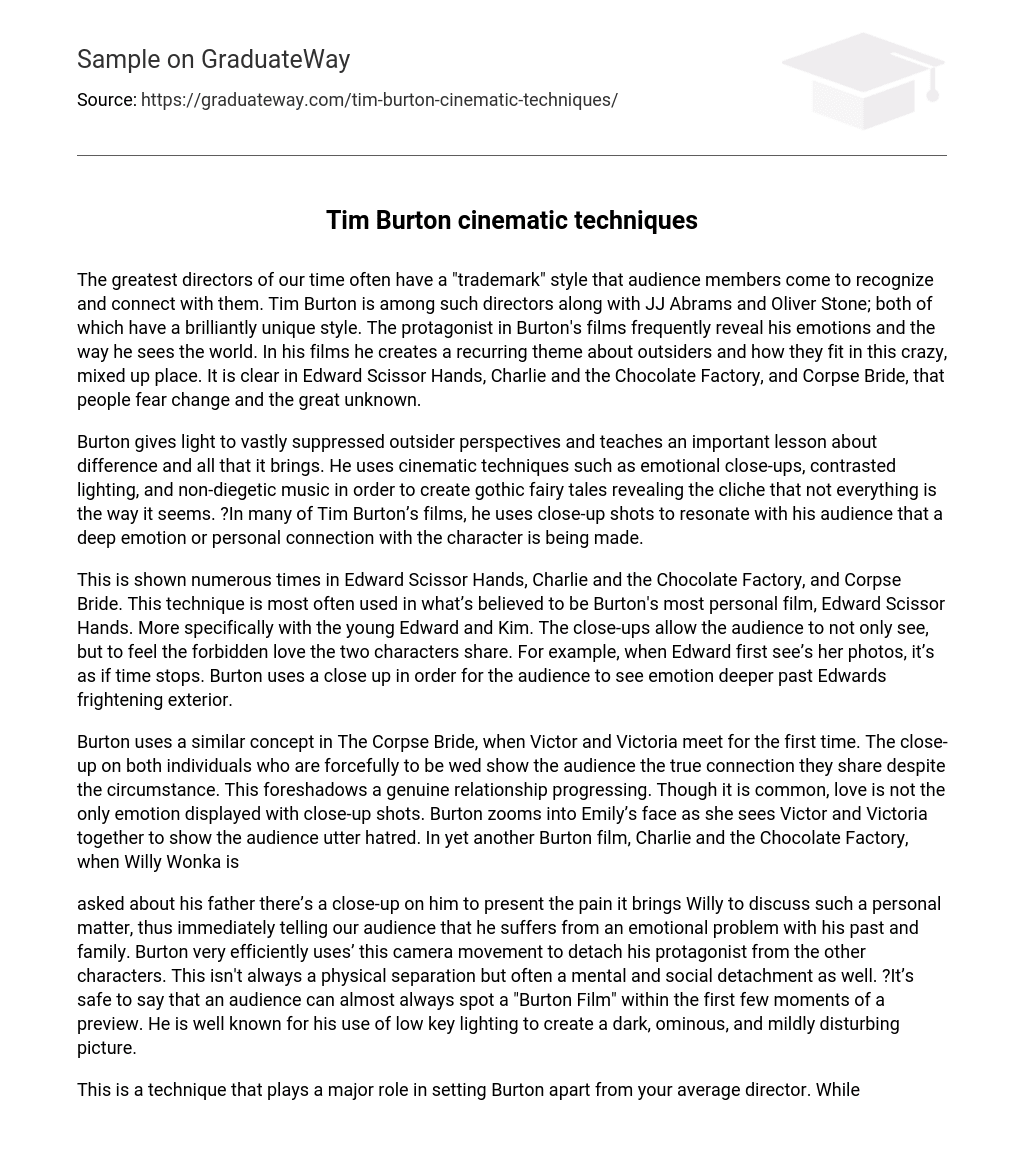The renowned directors of our era frequently possess a distinctive style that viewers readily identify and associate with them. Tim Burton, along with JJ Abrams and Oliver Stone, is one such director who exhibits a wonderfully one-of-a-kind style. In Burton’s movies, the lead characters often expose their emotions and perception of the world. Throughout his works, he consistently explores the theme of outcasts and their struggles to adapt in this chaotic and bewildering existence. This fear of change and unfamiliarity is evident in films such as Edward Scissor Hands, Charlie and the Chocolate Factory, and Corpse Bride.
Burton sheds light on marginalized perspectives that are often suppressed and imparts a crucial message regarding the significance of diversity. He employs various cinematic techniques like emotional close-ups, contrasting lighting, and non-diegetic music to craft gothic fairy tales that unveil the cliché that appearances can be deceiving. In numerous Tim Burton films, he utilizes close-up shots to establish a profound emotional bond or personal connection with the audience.
The utilization of this technique can be observed multiple times in Edward Scissor Hands, Charlie and the Chocolate Factory, and Corpse Bride. Its prominent use can be seen in what is considered to be Burton’s most personal film, Edward Scissor Hands, particularly in the case of young Edward and Kim. Through close-up shots, the audience is able to not only visually perceive, but also emotionally connect with the forbidden love shared by the two characters. For instance, when Edward first encounters her photographs, time appears to come to a standstill. By employing close-ups, Burton enables the audience to delve deeper into the emotions beyond Edward’s terrifying appearance.
In Burton’s film, The Corpse Bride, there is a similar concept where Victor and Victoria meet for the first time. The audience witnesses a close-up shot of both characters who are being forced into marriage, revealing their true connection despite the circumstances. This serves as a foreshadowing of their genuine relationship. Close-up shots are not solely used to portray love; Burton also employs this technique by focusing on Emily’s face as she observes Victor and Victoria together, displaying her intense hatred to the audience. Another instance of this technique can be seen in Burton’s film, Charlie and the Chocolate Factory, with a close-up shot specifically featuring Willy Wonka.
When asked about his father, Willy’s close-up highlights the pain he experiences when discussing such a personal matter. This effectively communicates to the audience that Willy has emotional issues related to his past and family. Additionally, Burton uses this camera movement to create distance between his protagonist and other characters, both physically and mentally/socially. Consequently, it can be said that audiences can easily identify a “Burton Film” within the first few moments of a preview due to his frequent use of low key lighting. This technique helps him establish a dark, foreboding, and slightly unsettling atmosphere.
One significant factor that sets Burton apart from other directors is his use of lighting. Despite his preference for low key lighting, he often combines it with high key lighting and bold colors. This is accompanied by uplifting music to create a utopian atmosphere. In Edward Scissorhands, Burton portrays a seemingly perfect town with bright pastel hues and a warm ambiance. However, he contrasts this with a dark castle in the distance, emphasizing its isolation.
From the beginning, the eerie castle in Edward Scissorhands establishes a sense of separation between Edward and the townspeople, building the notion of him as a mysterious protagonist. This technique is also employed in other Tim Burton films like Charlie and the Chocolate Factory, where a grey, melancholy town contrasts with the vibrant and imaginative world within Willy Wonka’s factory. The factory’s true nature is hidden from the general public, only revealing its wonders to a chosen few.
In Tim Burton’s films, there is a consistent theme of twisting and subverting expectations. For instance, in Corpse Bride, he portrays a town immersed in morbidity. However, instead of contrasting it with a factory or castle as one might expect, he presents the beautiful land of the dead. It is ironic that the deceased are depicted as the most joyful and vibrant characters. Nevertheless, Burton often showcases gothic mannerisms as unique and delightful settings in his movies. His underlying message is that embracing individuality can lead to happiness and that appearances can be deceiving.
One often overlooked technique that Tim Burton uses very precisely is his use of non-diegetic music. In Edward Scissor Hands, Burton employs a wide variation of music to enhance the storytelling. Whenever Edward sees Kim, a light and whimsical song is played, foreshadowing Edward’s developing feelings for her. In Charlie and the Chocolate Factory, music is used to create a contrast between Charlie Bucket’s depressing life and the magical factory. Sorrowful music accompanies scenes featuring Charlie’s home, evoking a sympathetic mood, while upbeat music accompanies the factory scenes.
Corpse Bride, like many of Tim Burton’s films, showcases a similar style. The living world is characterized by dreary, ominous music, while the land of the dead features a vibrant jazz town that exudes an energetic “life” despite being filled with deceased characters. This playful portrayal of death aligns with the recurring themes in Burton’s works. Music plays an integral role in constructing the desired mood and tone that are synonymous with Burton’s signature style. His film genius and impact in this generation can be attributed to his adept use of cinematic techniques, including close-up shots, contrasting lighting, and non-diegetic music.
Although they may appear as minor details, they all contribute significantly to the creation of the underlying message that Burton aims to convey: appearances can be deceiving and a solitary existence does not necessarily equate to unhappiness. Burton presents an extraordinary viewpoint that a life of uniqueness can bring bliss in the midst of misunderstanding. The stylistic techniques of this remarkable director can never be fully explained, but that is precisely how Tim Burton prefers it.





